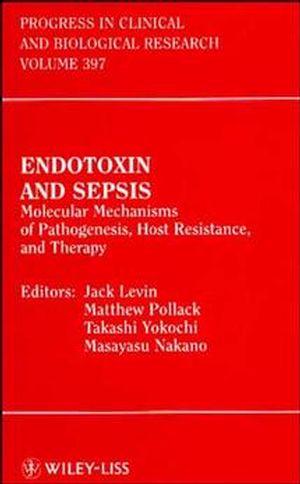Endotoxin and Sepsis: Molecular Mechanisms of Pathogenesis, Host Resistance, and TherapyISBN: 978-0-471-19432-3
Hardcover
398 pages
April 1998
 This is a Print-on-Demand title. It will be printed specifically to fill your order. Please allow an additional 10-15 days delivery time. The book is not returnable.
|
||||||
Biosynthesis of Escherichia coli 09 Polysaccharide and its Evolution (N. Kido).
Core Structure, of Enterobacterial Lipopolysaccharides (O. Holst, et al.).
Unique Structural and Biological Features of Helicobacter pylori Lipopolysaccharides (A. Moran & G. Aspinall).
What We Know and Don't Know about the Chemical and Physical Structure of Lipopolysaccharides in Relation to Biological Activity (S. Müller-Loennies, et al.).
Roles for LBP and Soluble Cd14 in Cellular Uptake of LPS (R. Tapping, et al.).
Structure-Function Analysis of Soluble and Membrane-Bound CD14 (T. Kirkland & S. Viriyakosol).
Roles of CD14 in LPS Signaling and Scavenging: Analysis of CD14-Transgenic and Non-Transgenic Mice and Rats in Response to LPS (S. Yamamoto, et al.).
The Role of Scavenger Receptors in LPS-Induced Macrophage Activation (T. Kirikae, et al.).
The CD11/CD18 Integrins: Characterization of Three Novel LPS Signaling Receptors (R. Ingalls, et al.).
The Role of Tyrosine Kinases and MAP Kinases in LPS-Induced Signaling (A. DeFranco, et al.).
CD14 Dependent and Independent Signaling Pathways in Murine Macrophages from Normal and CD14 "Knockout" (CD14KO) Mice Stimulated with LPS or Taxol (S. Vogel, et al.).
ADP-Ribosylation: Role in LPS-Induced Phosphorylation of Two Cytosolic Proteins (p36/38) in Monocytes (S. Hauschildt, et al.).
CD14 Dependent Mechanisms of Cell Activation (J. Han, et al.).
Cytokine Regulation of Inducible Nitric Oxide Synthase in Vascular Smooth Muscle Cells (J. Cohen, et al.N).
Detoxification of Lipopolysaccharide by Lysozyme (N. Ohno, et al.).
Role of Hepatocytes in the Clearance of Lipopolysaccharide and its Clinical Significance (K. Tanikawa, et al.).
Antibiotic-Mediated Release of Endotoxin and the Pathogenesis of Gram-Negative Sepsis (D. Morrison).
Molecular Mechanisms Responsible for Endotoxin Tolerance (B. Yoza, et al.N).
Endotoxin Tolerance Alters Macrophage Membrane Regulatory G Proteins (M. Makhlouf, et al.).
Lipopolysaccharide (LPS) Antibodies Regulate Cellular Uptake of LPS and LPS Induced Proinflammatory Responses (C. Ohl & M. Pollack).
Apoptotic Cell Death in Response to LPS (T. Yokochi, et al.).
Stimulation of Human T Lymphocytes by Lipopolysaccharide (LPS) in the Presence of Autologous and Heterologous Monocytes (T. Mattern, et al.).
Role of CD14 in Infection: Studies in CD14-Deficient Mice (A. Haziot, et al.).
Reconciling the Concepts of Endotoxin Sensitization and Tolerance (M. Freudenberg, et al.).
Production of Nontoxic Lipid A by Chemical Modification and its Antagonistic Effect on LPS Activity (K. Tanamoto).
The Protective Effect of Prostaglandin E1 on Endotoxin-Induced Hepatocyte Injury (H. Shimada, et al.).
Natural and Synthetic LPS and Lipid A Analogs or Partial Structures that Antagonize or Induce Tolerance to LPS (N. Qureshi, et al.).
The Molecular Basis for Therapeutic Concepts Utilizing CD14 (F. Stelter, et al.).
Natural and Synthetic Polypeptides that Recoggnize the Conserved Lipid A Binding Site of Lipoplysaccharides (M. Porro, et al.).
Prevention of Endotoxin Shock through Targeting Leukocytes Adhesion Molecules (H. Higashi, et al.).
Suppression of TNF and other Proinflammatory Cytokines by the Tetravalent Guanylhydrazone CNI-1493 (K. Tracey).
Interaction of Lipopolysaccharide with a Mammalian Lyso-phosphatidate Acyltransferase (LPAAT) Tranfected into E.
coli, and Effect of Lisofylline on LPAAT Transfected into Mammalian Cells (S. Bursten).
Role of Nitric Oxide and Reactive Oxygen Species in Endotoxin Shock (T. Yoshikawa, et al.).
The Role of Interleukin 6 in Endotoxin-Induced Inflammatory Responses (T. van der Poll & S. van Deventer).
The Pathogenic Role of LBP in Gram-Negative Sepsis and Septic Shock (D. Heumann, et al.).
Index.



